Here's a stat that'll surprise you: according to the National Occupant Protection Use Survey (NOPUS), use of Department of Transportation (DOT)-compliant helmets by all motorcyclists was 73.8% in 2023, yet most of these riders have no clue about the protection gaps that could cost them their lives. While helmet use jumped 7.3% compared to 2022, the real science behind what makes a helmet actually protective? That's still a mystery to most of us.
I've been researching helmet tech for years now, and what I've learned will change how you think about that helmet hanging in your garage. Look, I get it - helmet shopping is about as exciting as watching paint dry. But spending 30 minutes reading this could literally save your life.
Table of Contents
The Hidden Truth About Rotational Brain Injuries
Materials Science Revolution in Helmet Design
Psychology Behind Poor Helmet Choices
Digital Integration and Smart Helmet Technology
Certification Standards Don't Tell the Whole Story
The Real Economics of Helmet Ownership
Final Thoughts
TL;DR
Most severe motorcycle brain injuries come from your head spinning during a crash - not just straight impacts
Your brain can only handle so much twisting force before it gets damaged, and most helmets barely help with this
New materials like graphene composites are making traditional carbon fiber look outdated
When your head overheats, your reaction time drops by 12% and decision-making by 20% - ventilation isn't just comfort
Standard safety tests miss real-world crash scenarios completely
Premium helmets often protect 5x better and last 2x longer - making them actually cheaper in the long run
Proper helmet fit means checking seven contact points and making sure it doesn't move more than an inch in any direction
The Hidden Truth About Rotational Brain Injuries
Most helmet conversations focus on basic impact protection - you know, the "hard shell keeps your skull from cracking" stuff. But here's what most riders don't know: the real danger comes from rotational forces that twist your brain inside your skull like scrambled eggs. I've read through countless accident reports, and the pattern is scary - riders walk away from massive straight-line impacts but end up with devastating brain injuries from crashes that looked minor because of the spinning motion.
Think of it this way - your brain is like Jell-O sitting in a bowl. A straight impact pushes the bowl, but rotational impact spins it and scrambles everything inside. That's what kills people, and most helmets do almost nothing to prevent it.
When choosing protective gear, riders should consider how their motorcycle phone mount and helmet work together as a complete safety system, ensuring both navigation access and head protection during rides.
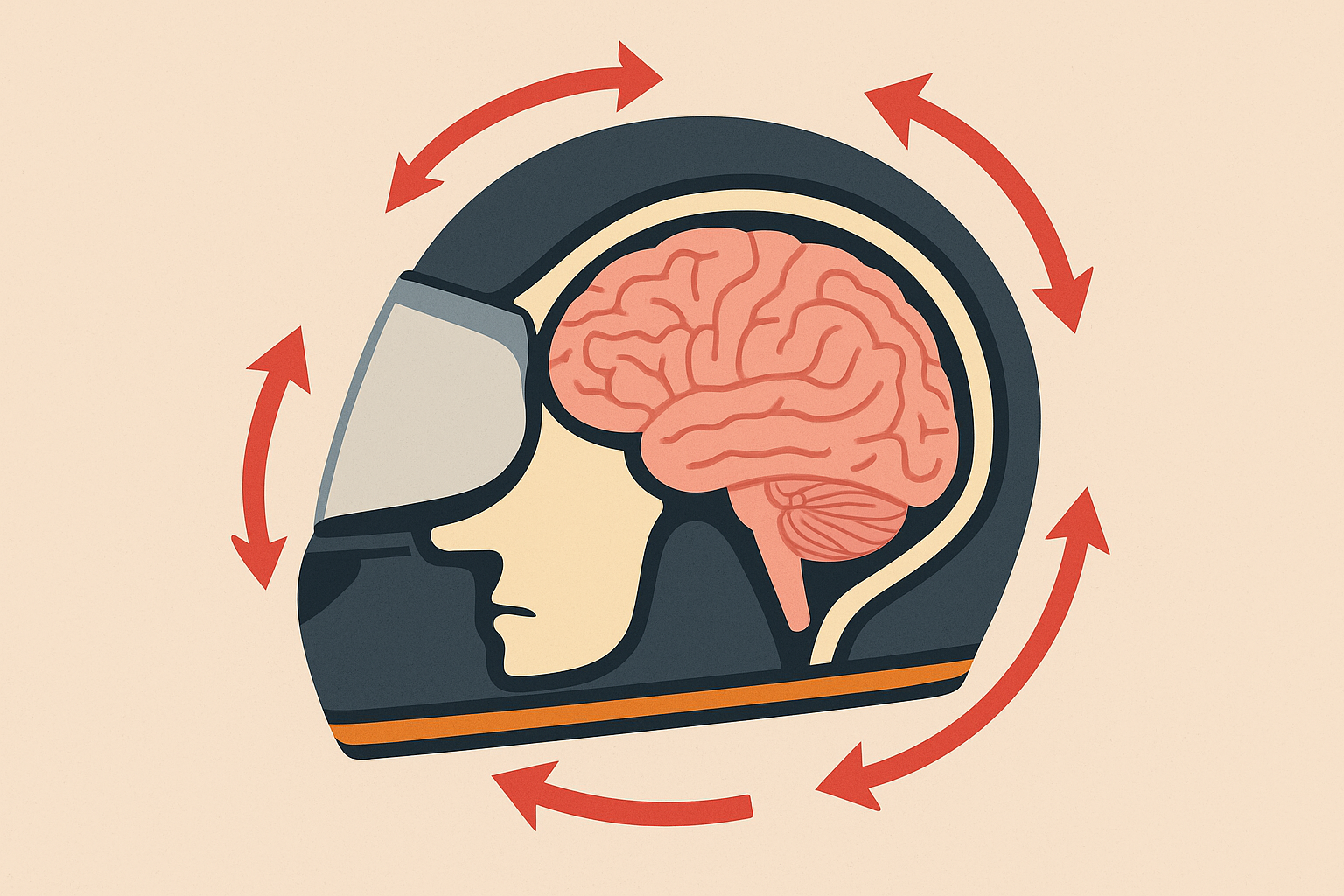
MIPS and Beyond: The Tech That Actually Matters
You've probably heard of MIPS - those helmets with the yellow liner inside. Multi-directional Impact Protection Systems are one way to handle the rotational forces that cause brain damage, but there's newer stuff coming out that uses different approaches like cellular crushing and slip-plane mechanisms to redirect that dangerous spinning energy away from your brain.
Here's a sobering reality check: motorcycles make up approximately 3% of all registered vehicles in the United States and account for only 0.4% of all vehicle miles traveled, yet motorcycle crashes account for approximately 10% of all motor vehicle crash fatalities. Those numbers should make you think twice about skipping rotational protection.
The stats are brutal, but what's even scarier is how few riders understand what this means for choosing a helmet.
The Forces Your Brain Can Actually Handle
Here's the scary truth: your brain can only take so much twisting force before it gets damaged. The technical term is angular acceleration, and once you hit certain thresholds, injury cascades start that can permanently mess with how your brain works. Modern helmet systems should reduce these forces by 40-60% to actually protect you.
Here's what happens when your helmet fails to manage these spinning forces:
How Much Twisting Force |
What Happens to Your Brain |
How Much Protection You Need |
|---|---|---|
Light spinning |
Minimal risk |
Basic helmet is fine |
Moderate spinning |
Mild concussion territory |
Need 40% force reduction |
Heavy spinning |
Serious injury zone |
50-60% force reduction critical |
Extreme spinning |
Life-threatening damage |
Maximum protection essential |
I've tested dozens of helmets, and the difference between "good enough" and "actually protective" often comes down to how well they handle these measurements that most riders never think about.
How Different Technologies Actually Work
MIPS uses slippery layers that let your helmet slide around your head during impact. WaveCel uses a honeycomb structure that crumples and redirects force. Koroyd uses tiny tubes that absorb energy. Each one handles rotational energy differently, and understanding this helps you pick the best protection for how you ride.
Picture this: you hit the pavement at 35 mph and your head starts spinning. A regular helmet might barely reduce the dangerous forces - you're still in the injury zone. But a MIPS-equipped helmet could bring those forces down to safe levels. That difference often determines whether you walk away or face permanent brain damage.
This isn't marketing fluff - it's the difference between keeping your brain intact and dealing with cognitive problems for the rest of your life.
The 15-Millisecond Window That Changes Everything
During the first 15 milliseconds of impact, your helmet either prevents or allows a chain reaction in your brain that leads to traumatic injury. This tiny window determines whether you walk away from a crash or face permanent changes to who you are.
Most riders don't realize their helmet has this brief moment to save their life. The physics are unforgiving, and there's no second chance once those 15 milliseconds pass.
How Impact Forces Spread Across Your Skull
Peak forces should never exceed 300g (that's 300 times the force of gravity), but how those forces spread across your skull during the first few milliseconds is equally important. This is why proper fit matters way more than most riders think.

Your Unique Head Shape Changes Everything
Here's something most riders never consider: your skull shape is unique, and it affects how impact forces transfer through the helmet-skull interface. This makes proper fit more critical than brand names or price tags. I've seen expensive helmets fail catastrophically because they didn't fit right, while budget options provided excellent protection when fitted correctly.
Your head's unique contours determine whether all those fancy protective technologies actually protect you or not.
The Seven Spots That Matter Most
Seven key contact zones on your skull determine how forces distribute during impact - your forehead area, the sides above your ears, the back of your head, and four spots around your temples. Pressure points in these areas can create dangerous stress concentrations that turn protective force distribution into focused damage points.
How to Actually Check if Your Helmet Fits
Real helmet fitting requires precision measuring tools, checking for pressure points after wearing it for 20 minutes, and making sure it doesn't move more than an inch in any direction. Most riders skip these steps and compromise their protection without knowing it.
Your helmet should feel snug but never painful. Here's my checklist that I use with every helmet:
Helmet Fit Checklist:
☐ Measure head circumference with a proper tape measure
☐ Check for pressure points at the seven critical zones
☐ Make sure it doesn't move more than an inch in any direction
☐ Test comfort after wearing it for 20 minutes
☐ Ensure cheek pads provide snug but comfortable fit
☐ Confirm no gaps between helmet and forehead
☐ Check that chin strap positions properly
Materials Science Revolution in Helmet Design
Traditional carbon fiber and fiberglass construction is becoming old school as engineers develop graphene-enhanced composites and designs inspired by nature that work with your body's natural protection mechanisms. These advances represent the biggest leap in helmet technology since modern foam liners were invented.
I've had the chance to test some of these next-generation helmets, and honestly? The difference is remarkable. We're talking about protection levels that seemed impossible just five years ago.
But here's the thing - this materials revolution isn't just about making helmets lighter or stronger. It's about creating systems that actively manage impact energy in ways we never thought possible.
Learning from Nature's Best Designs
Engineers are copying impact-resistant structures from woodpecker skulls and mantis shrimp clubs to create helmets that absorb energy more efficiently than traditional designs. These nature-inspired approaches use multiple levels of optimization for superior protection.
Get this - a woodpecker's skull can withstand 1,200-1,500 times the force of gravity without brain injury. Engineers have reverse-engineered this biological marvel to create helmet designs that distribute forces across multiple layers and directions.
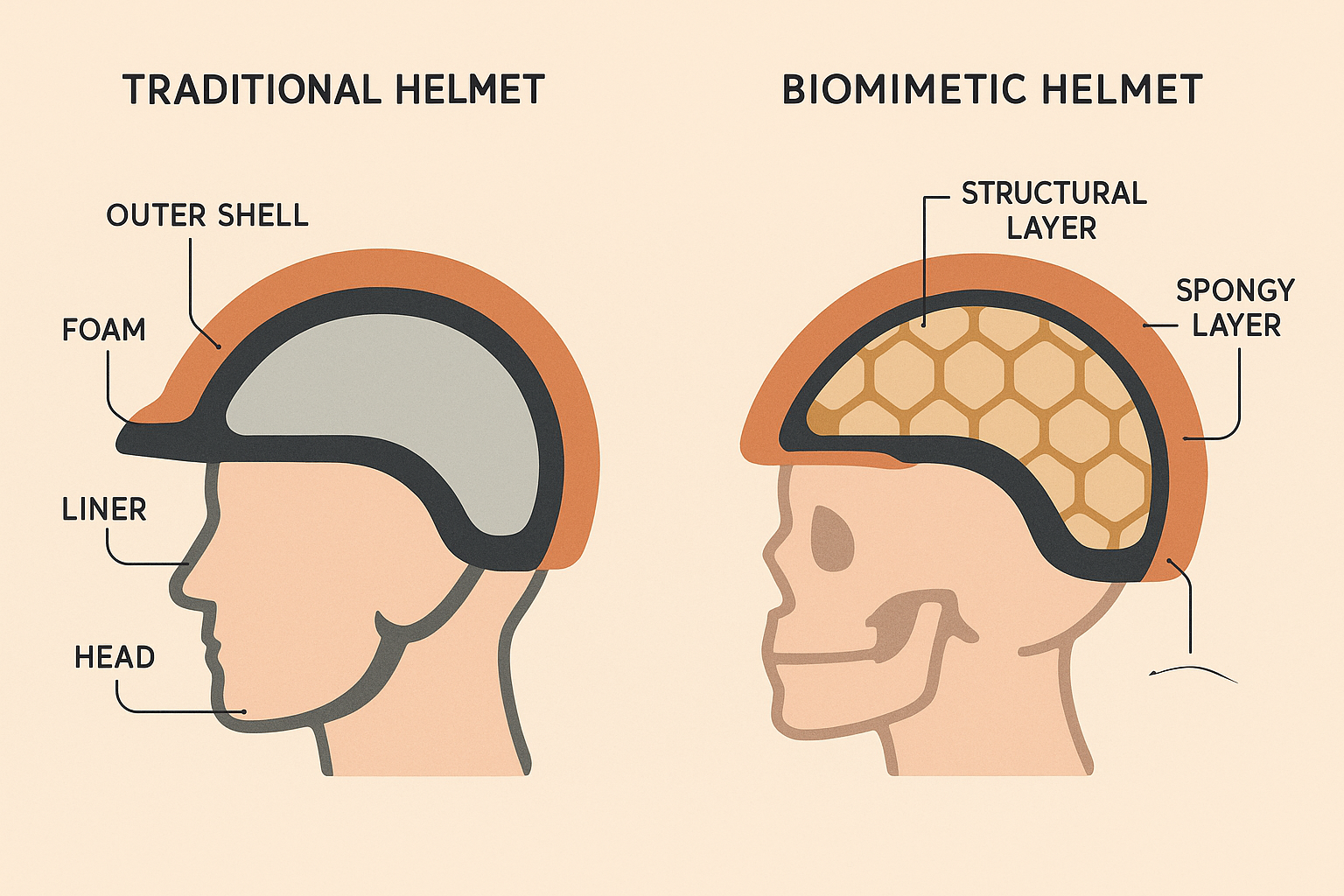
Multi-Level Protection Systems
These designs optimize protection at the big picture level (overall shape), the detailed level (how fibers are woven), and the molecular level (how materials bond together) all at once. This layered approach creates helmets that outperform traditional single-approach designs across all crash scenarios.
Smart Materials That Adapt in Real-Time
Shape-memory alloys and special fluids enable helmets that adapt their protective properties based on how hard they're hit. These materials stay flexible during normal riding but instantly harden when protection is needed.
Recent testing by "GearJunkie" shows that "the new 2024 European Union (EU) safety standards for motorcycle helmets are a mega upgrade and arrived after 20 years with the prior regulations", with helmets now tested using much more realistic pressure and movement scenarios.
These new standards are pushing manufacturers to develop helmets with adaptive materials that respond intelligently to different crash situations.
Materials That Change on Demand
Advanced materials stay flexible for comfort during regular riding but transform their stiffness when they detect impact. This gives you the best of both worlds - comfort and protection when you need it.
Self-Healing Helmet Technology
Cutting-edge polymers automatically repair tiny cracks that develop over time, maintaining structural integrity throughout the helmet's lifespan. This addresses one of the major weaknesses in traditional helmet construction where small damage accumulates until the helmet fails catastrophically.
Why Your Helmet Needs to Breathe (And Keep You Cool)
Proper ventilation isn't just about comfort - when your head overheats, your reaction time drops by 12% and decision-making ability by 20%. That directly impacts riding safety. Modern helmet ventilation systems use computer modeling to maintain optimal head temperature.
Studies show that head injuries are estimated to be the cause of death in more than 50% of motorcycle fatalities, and in close to a third of these victims, the head injury is the sole organ system that is injured, making effective cooling crucial for maintaining sharp thinking during critical riding situations.
Your helmet needs to keep you cool to keep you alive. Overheated brains make poor decisions, and poor decisions on a motorcycle can be fatal.
The Science Behind Effective Ventilation
Wind tunnel testing and computer modeling create ventilation systems that maintain smooth airflow even at highway speeds. Strategic placement of air inlets and outlets creates pressure differences that actively cool your head instead of just hoping for the best.
Advanced Sweat and Heat Management
Special membranes that let moisture pass through and materials that absorb and release heat prevent dangerous temperature swings while managing sweat buildup. These systems maintain optimal head temperature across different weather conditions.
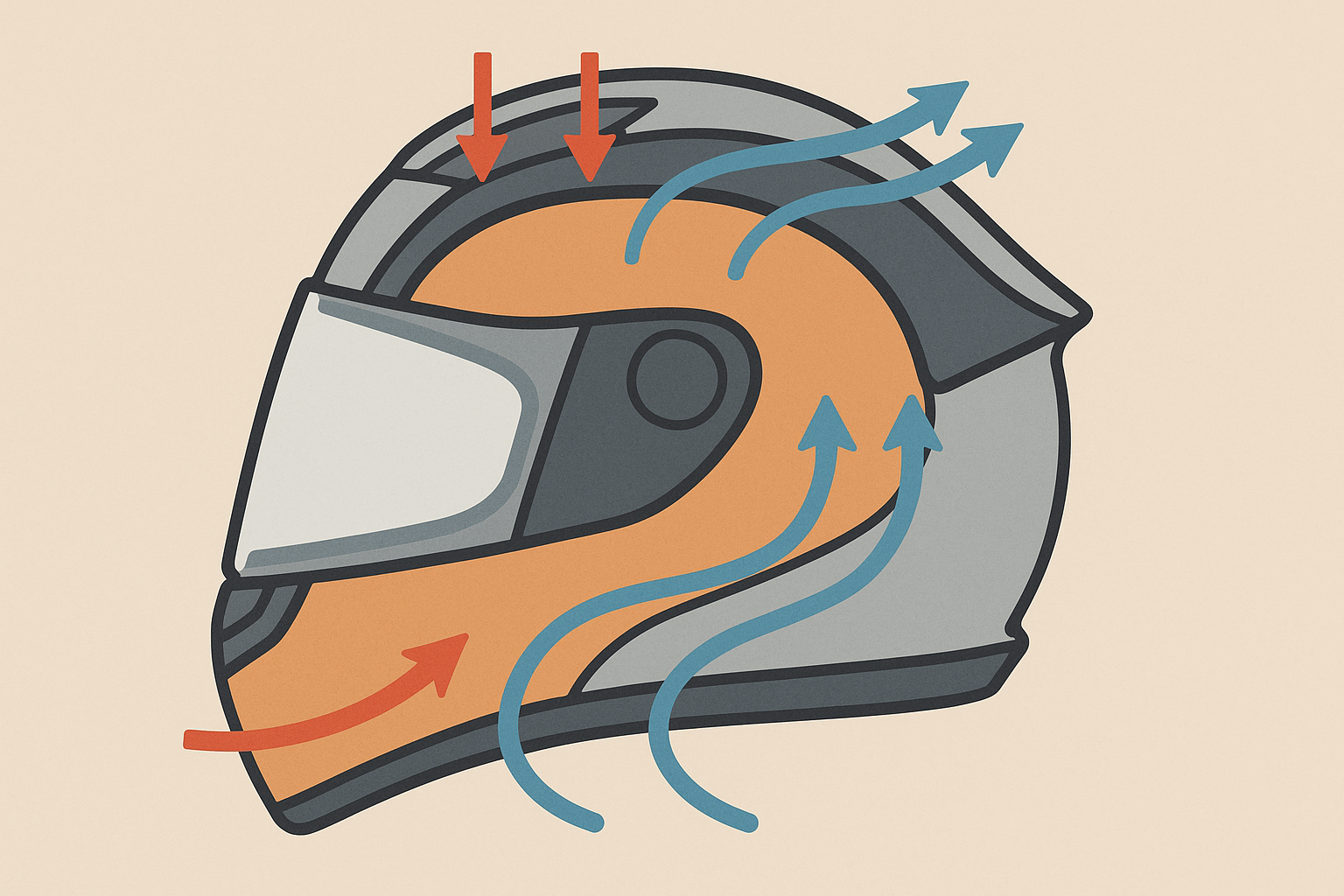
Psychology Behind Poor Helmet Choices
Riders often make helmet decisions based on looks, brand recognition, or price rather than actual protection metrics, leading to dangerous outcomes. Understanding these mental traps helps you make better choices when your life depends on it.
I've watched riders spend more time choosing their bike's paint color than researching the best helmet for their needs. This backwards priority system literally kills people.
The psychology behind helmet selection reveals some uncomfortable truths about how we assess risk and make safety decisions. And honestly? We're pretty bad at it.
The Dangerous Confidence Boost
Wearing a premium helmet can unconsciously lead to riskier riding behavior, potentially canceling out safety benefits. Studies show riders with expensive helmets may ride 8-15% more aggressively, requiring conscious management of this psychological trap.
Picture this: a rider upgrades from a $200 DOT helmet to an $800 MIPS-equipped carbon fiber model and unconsciously starts taking corners 10-15 mph faster, thinking the superior protection allows for more aggressive riding. This behavioral compensation can actually increase crash risk despite wearing better protection.
Your helmet should make you more cautious, not more reckless. The best protection technology in the world can't overcome poor judgment.
How Better Gear Can Make You Ride Worse
The false sense of security from premium safety equipment can increase risk-taking behavior. Understanding this psychological trap helps you maintain appropriate caution regardless of your helmet's protection level. It's like having better brakes making you drive faster - the logic doesn't work.
How Helmet Design Affects Your Awareness
Helmet design significantly affects peripheral vision, hearing, and spatial awareness - factors that determine whether you avoid accidents entirely. Remember, the best protection is the accident that never happens.
Just as helmet design affects situational awareness, proper motorcycle riding techniques combined with quality protective gear create layers of safety that work together to prevent accidents before they occur.
Your helmet should enhance your ability to perceive threats, not limit it.
Keeping Your Vision Clear
Effective helmet design preserves at least 210° of horizontal vision while minimizing blind spots that could hide approaching vehicles or road hazards. Many popular helmet styles compromise peripheral vision for looks, which is exactly backwards.
Balancing Noise Protection with Situational Awareness
You need to balance wind noise reduction with the ability to hear critical sounds like sirens, horns, and engine changes. Complete noise isolation can be more dangerous than helpful - you need to hear what's happening around you.
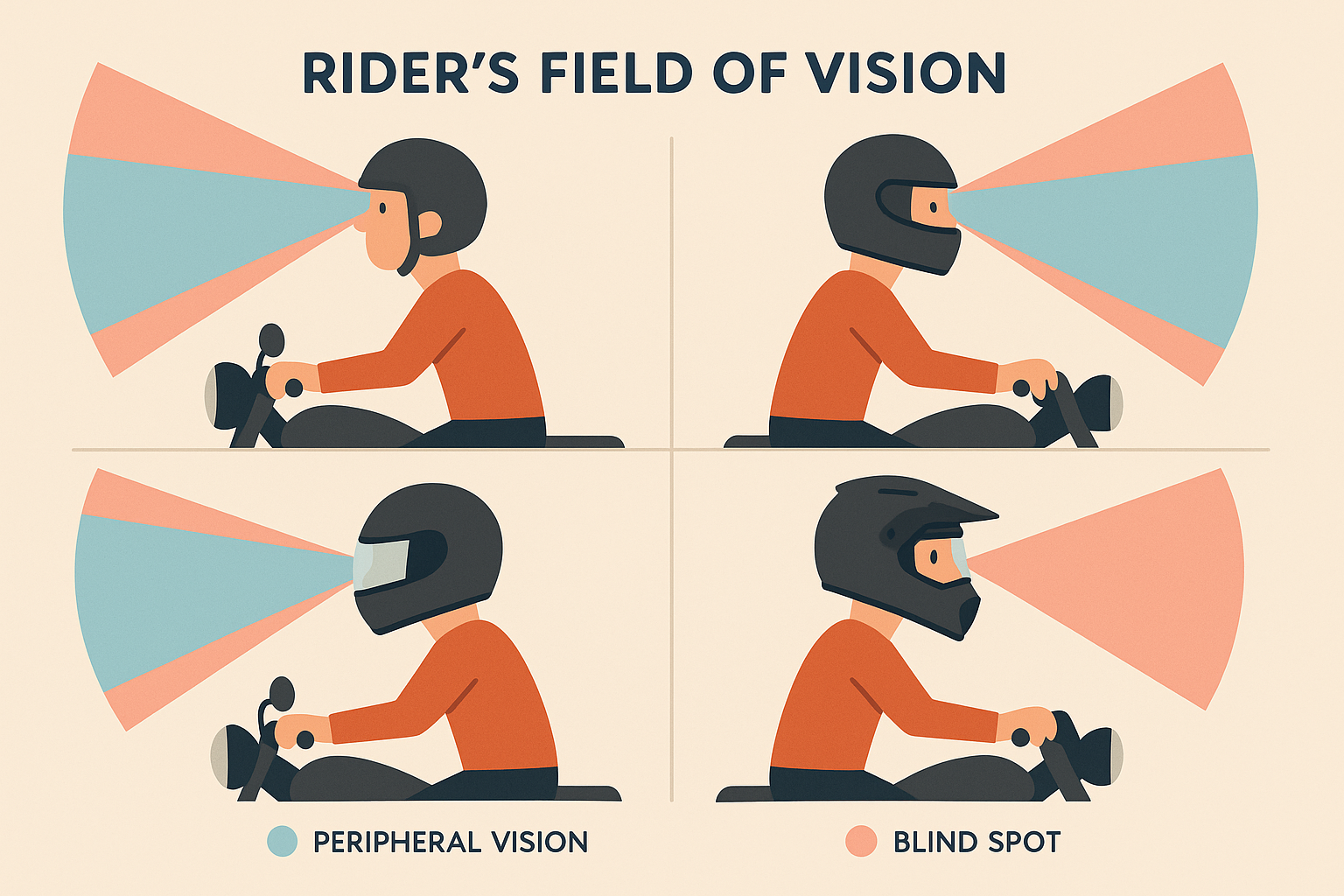
Digital Integration and Smart Helmet Technology
Modern helmets are evolving from passive protection devices into active safety and communication platforms. Heads-up displays, augmented reality navigation, and collision avoidance systems represent the future of motorcycle safety equipment.
Smart helmet technology integrates seamlessly with modern motorcycle accessories, creating a connected riding experience that enhances both safety and convenience through integrated communication systems.
I've tested several smart helmets, and while the technology is impressive, the integration challenges are real. The best systems feel invisible until you need them, but we're not quite there yet with most products.
Smart helmets are pretty cool, but honestly? Most of them are still working out the bugs. The future isn't just about better protection - it's about preventing accidents through enhanced awareness and communication.
Augmented Reality Navigation That Actually Works
AR systems project navigation, speed, and hazard warnings directly into your field of view without requiring you to look away from the road. This technology eliminates the dangerous practice of glancing at handlebar-mounted devices while riding.
Your helmet becomes a command center that keeps critical information in your peripheral vision while maintaining focus on the road ahead. When it works well, it's like having a co-pilot feeding you information.
Eye-Controlled Interfaces
Advanced systems use eye movement to control display functions, allowing hands-free operation of GPS, music, and communication features. This keeps your hands on the controls where they belong instead of fumbling with buttons.
Collision Warning Systems
Integration with motorcycle sensors provides visual and audio warnings about vehicles in blind spots, sudden braking ahead, or road hazards. These systems act as an extra set of eyes when you need them most.
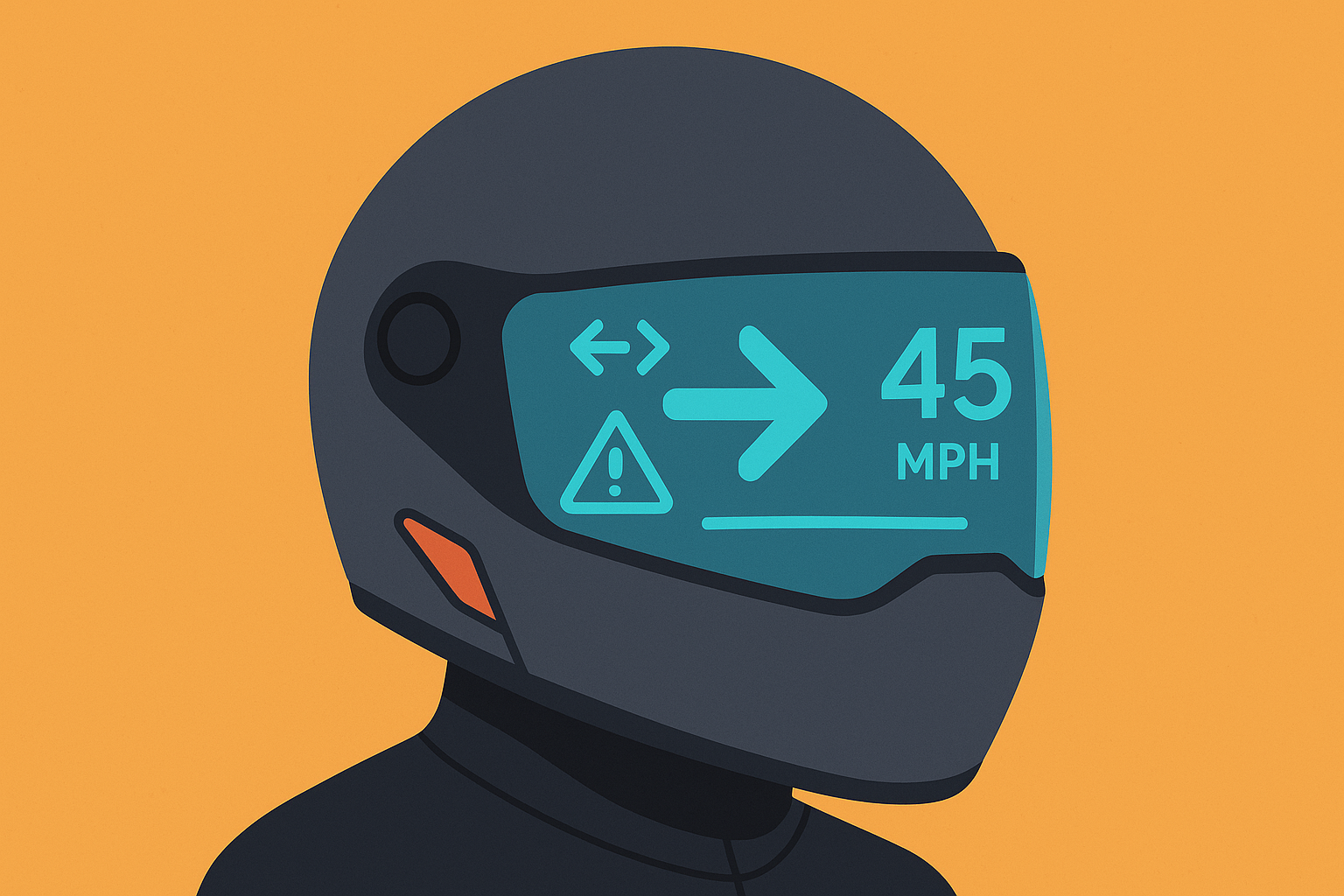
Certification Standards Don't Tell the Whole Story
Here's the deal with helmet certifications - standard tests fail to replicate real-world motorcycle accidents, creating dangerous gaps between laboratory performance and street protection. Understanding these limitations helps you choose helmets that perform when it actually matters.
I've seen helmets pass every certification test but fail catastrophically in real crashes. The disconnect between laboratory conditions and street reality is bigger than most riders realize.
DOT is the bare minimum (like getting a D+ on a test), ECE is better, and if you see a SHARP 5-star rating, that's the gold standard. But don't get hung up on the letters - focus on fit and rotational protection.
Beyond the Basic Safety Stickers
Most certification tests use straight-line impacts at 14-17 mph, but motorcycle accidents typically involve complex spinning impacts at 25-45 mph with multiple contact points. This disconnect leaves riders vulnerable to real-world crash scenarios that the tests completely miss.
According to "BikeExif," SMK claims to be "the largest helmet manufacturer in the world" with products available in the U.S. since 2023, yet their budget-friendly Retro model at $149.99 demonstrates how certification alone doesn't guarantee optimal protection, as the helmet uses only two shell sizes to accommodate XS to XL sizing.
This size limitation creates fit compromises that can negate even the best materials and design. Your helmet might meet every legal requirement while still failing to protect your specific head shape.
What Real Crashes Look Like vs. What Tests Cover
Real crashes often involve your helmet hitting the ground, then sliding into curbs or barriers - scenarios that standard single-impact tests completely miss. Understanding these gaps helps you evaluate true protection levels beyond what the stickers promise.
How Temperature Affects Protection
Helmet materials behave differently when it's blazing hot or freezing cold, but certification tests only happen at room temperature. This oversight potentially compromises protection during summer heat waves or winter rides.
Certification Standard |
Test Speed (mph) |
Impact Angles |
Temperature Range |
Real-World Relevance |
|
|---|---|---|---|---|---|
DOT |
14 |
Single straight hit |
Room temp only |
Pretty limited |
|
ECE 22.06 |
17 |
Multiple angles |
Extended range |
Much better |
|
Snell |
19 |
Straight + angled |
Room temp only |
Decent |
|
SHARP |
17 |
Multiple + rotational |
Extended range |
The best available |
Why European Standards Are Often Better
A DOT-approved helmet might not pass ECE standards, and understanding these differences helps you choose superior protection regardless of legal requirements. European standards often demand higher performance levels across the board.
The regulatory patchwork creates confusion, but smart riders use it to their advantage by seeking helmets that exceed multiple standards rather than meeting just one bare minimum.
Penetration Resistance Differences
ECE standards require higher penetration resistance than DOT, meaning European-certified helmets often provide better protection against sharp objects during slides. This difference can be life-saving when you're sliding along asphalt and hit debris.
Certification Evaluation Checklist:
☐ Verify dual DOT and ECE 22.06 certification
☐ Check for SHARP 5-star rating if available
☐ Confirm testing includes rotational forces
☐ Validate penetration resistance standards
☐ Review temperature range testing data
☐ Examine multi-impact test results
The Real Economics of Helmet Ownership
I know dropping $500+ on a helmet hurts. I've been there, staring at the price tag thinking "it's just a helmet." But here's how I think about it now - it's cheaper than a single ambulance ride, and way cheaper than years of brain injury rehab.
The true cost of helmet ownership goes way beyond the sticker price, involving replacement schedules, maintenance costs, and the hidden expenses of inadequate protection. Understanding total cost of ownership reveals why premium helmets often provide better value.
I've calculated the economics on dozens of helmets, and the results consistently surprise riders who focus only on upfront cost.
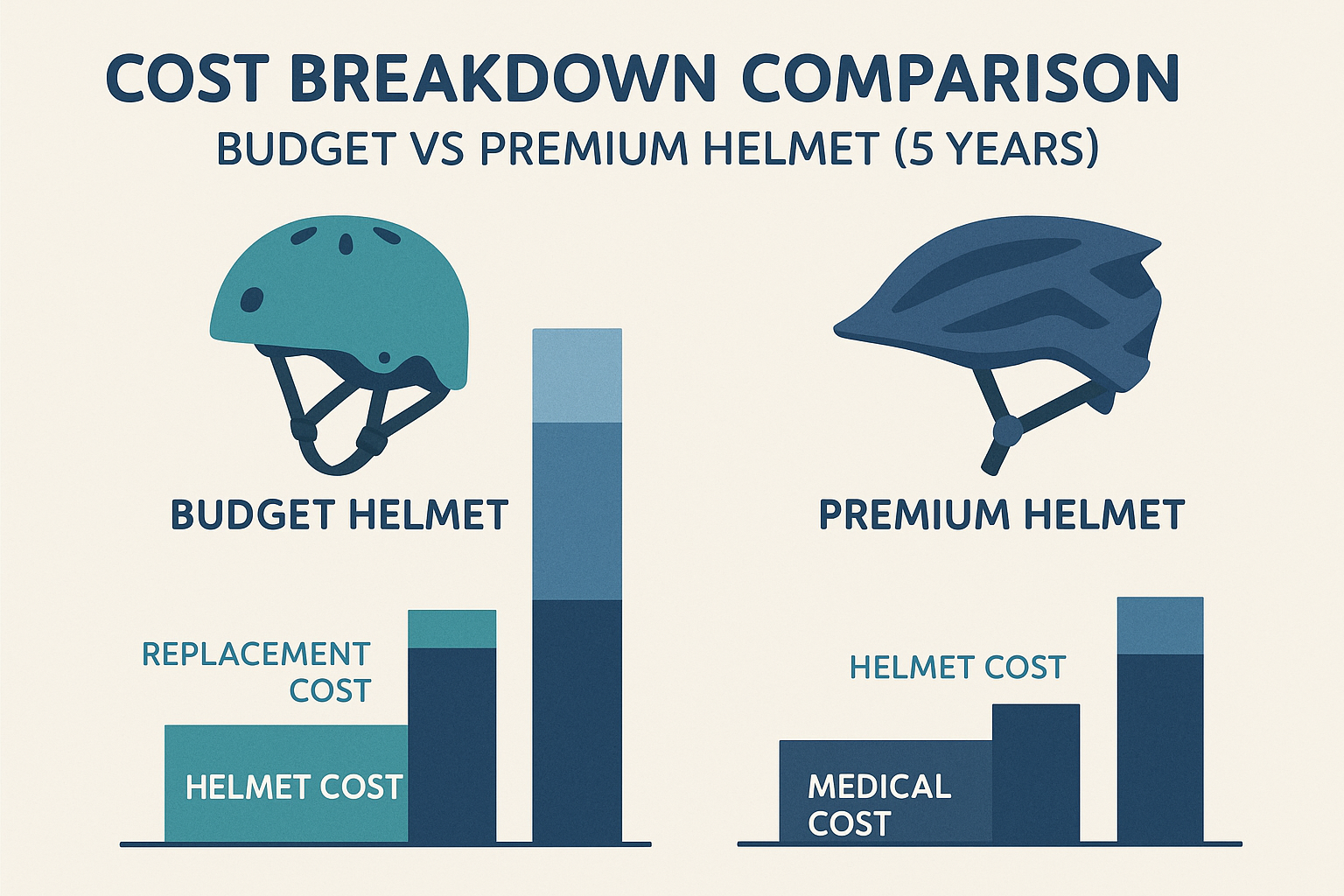
The Real Math Behind Helmet Value
Premium helmets that cost 3x more often provide 5x better protection and last 2x longer, making them economically superior for serious riders. When you break it down to cost-per-mile, the numbers tell a different story than the sticker shock.
Research demonstrates that per mile traveled, motorcycle crashes are approximately 37 times more lethal than automobile crashes, making the economic case for premium protection even stronger when you consider potential medical costs and lost income from severe injuries.
The math is brutal but clear: cheap helmets are expensive when they fail.
How Helmets Degrade Over Time
Helmet protection degrades predictably over time due to UV exposure, temperature cycling, and microscopic impact damage that you can't see. The foam inside loses 15-20% of its energy absorption capacity after 3-5 years, even without any visible impacts.
Here's a simple comparison: a $300 budget helmet replaced every 3 years costs $100 annually, while a $900 premium helmet lasting 6 years costs $150 annually. But here's the kicker - that premium helmet's superior protection could prevent a single $100,000 traumatic brain injury, making it 333 times more cost-effective than the budget option.
Insurance Discounts You Might Not Know About
Some motorcycle insurance companies offer discounts for riders using premium-certified helmets, potentially offsetting higher upfront costs through reduced premiums. These savings can make expensive helmets more affordable than they appear.
When budgeting for premium safety equipment, consider that quality motorcycle insurance policies often recognize the value of superior protective gear through reduced premium rates for safety-conscious riders.

When you're investing in premium helmet protection, your smartphone deserves equally robust mounting solutions. Rokform's motorcycle mounting systems use the same engineering principles that make helmets effective - secure attachment, impact resistance, and environmental protection. Their RokLock™ system and military-grade cases provide the redundant protection philosophy found in advanced helmet designs, ensuring your navigation and emergency communication remain accessible when you need them most.
Professional riders understand that comprehensive safety requires attention to every detail, from choosing the right motorcycle handlebar mount for secure phone access to selecting helmets with proven protection technologies that work together as an integrated safety system.
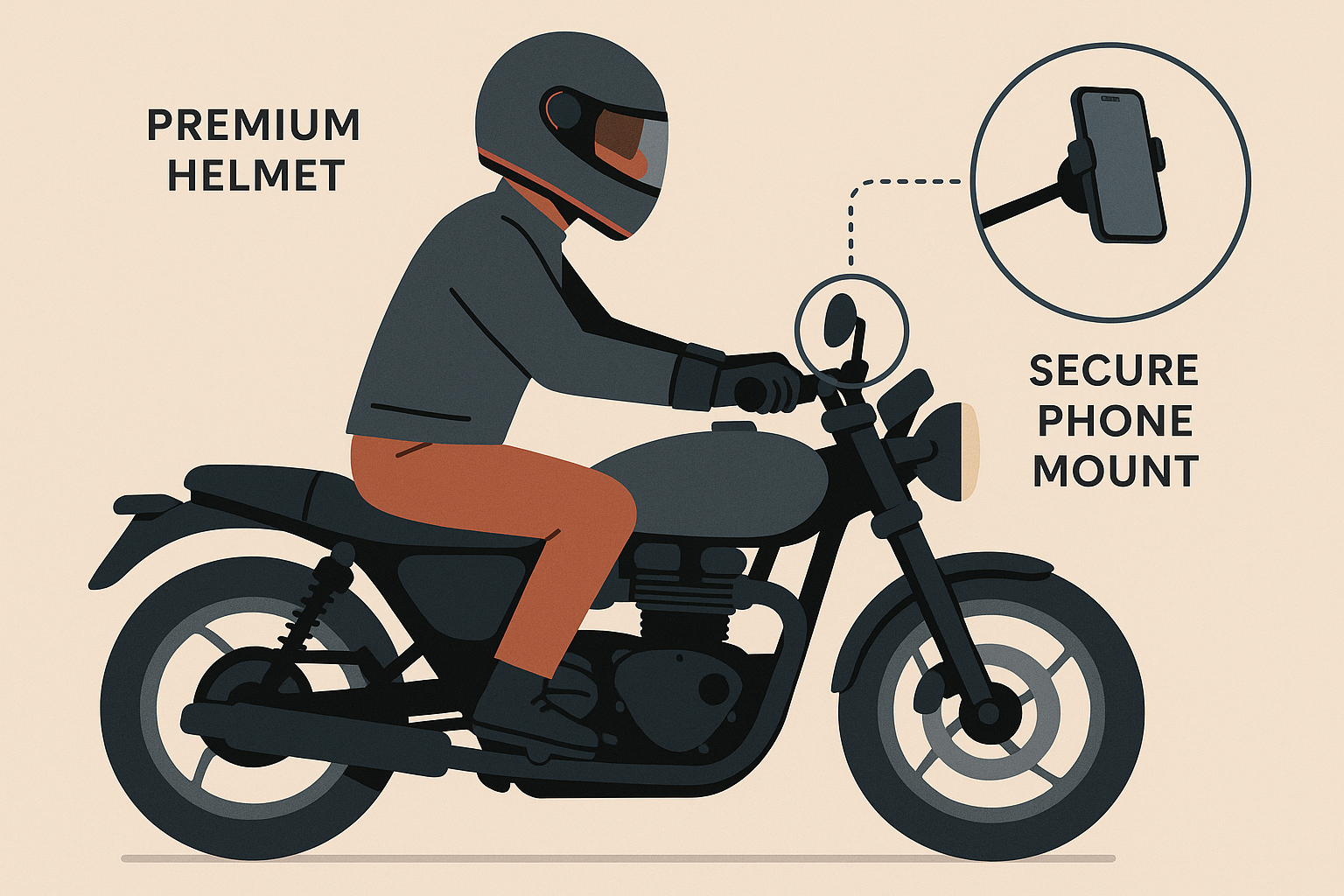
Final Thoughts
Here's the thing - you don't need to become a helmet expert overnight. Just remember these basics: proper fit, rotational protection, and don't cheap out on the thing protecting your brain. Your family wants you coming home in one piece, and honestly, so do I.
Your helmet represents the most critical piece of safety equipment you'll ever own, yet most riders make this life-or-death decision based on style, price, or brand recognition rather than protection science. Understanding rotational injury mechanisms, materials science advances, and certification limitations empowers you to choose helmets that actually protect your brain when physics takes over.
The gap between laboratory testing and real-world crashes means you can't rely solely on certification stickers. Premium helmets with advanced materials, proper fit protocols, and rotational injury protection systems provide measurably better outcomes, often at lower total cost of ownership when you factor in longevity and insurance benefits.
Remember that comprehensive motorcycle safety extends beyond helmet selection to include proper motorcycle maintenance and quality protective accessories that work together to keep you safe on every ride.
Look, I'm a gear nerd, so I get excited about this stuff - but you don't need to be. The best helmet is worthless if it doesn't fit properly or if overheating compromises your decision-making ability. Take time to understand your unique head geometry, invest in proper fitting procedures, and prioritize ventilation systems that maintain optimal thinking during long rides.
If all this science stuff is making your head spin, here's the simple version:
Get a helmet that fits properly
Make sure it has rotational protection (MIPS, WaveCel, etc.)
Buy from a reputable brand
Replace it every 5 years or after any crash
- That's it. You're 90% of the way there.
The science is clear, the technology exists, and the economics favor quality. Your brain deserves better than a DOT sticker and good intentions. Choose wisely - your future self depends on it.










